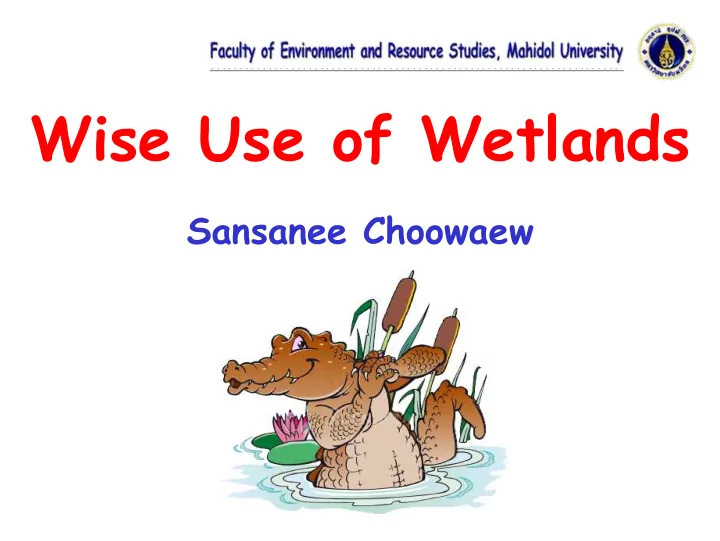

Wise Use of Wetlands Sansanee Choowaew
THE RAMSAR CONCEPT OF “WISE USE” Under Article 3.1 of the Ramsar Convention, Contracting Parties agree to “formulate and implement their planning so as to promote the conservation of the wetlands included in the List, and as far as possible the wise use of wetlands in their territory”.
WISE USE OF WETLANDS Definition of “wise use” (Ramsar Convention, 1987) “The wise use of wetlands is their sustainable utilization for the benefit of mankind in a way compatible with the maintenance of the natural properties of the ecosystem.” Sustainable utilization : Human use of a wetland so that it may yield the greatest continuous benefit to present generations while maintaining its potential to meet the needs and aspirations of future generations. Natural properties of the ecosystem : Those physical, chemical and biological components, such as soil, water, plants, animals and nutrients, and the interactions between them.
APPLYING the “WISE USE” CONCEPT • Human use on a sustainable basis is entirely compatible with the “wise Use” Sustainable Use = Wise Use • Applies to ALL wetlands and water resources in a Contracting Party’s territory, NOT ONLY to Ramsar Sites • Requires national policies and measures; and appropriate use activities in wetland sites • Local communities participate in defining activities, use patterns, rates of uses, and equitable benefit sharing
SOME WISE USE GUIDELINES • Focus on local populations, indigenous knowledge; respectful to traditional uses/local cultures • Social and economic factors (the main causes of wetland loss) are of central concern in wise use programmes • Interdisciplinary approach (hydrology, biology, geology, chemistry, economics, social sciences, policy, laws, etc.) • Ecosystem approach (river basin-based; not just the coastal zone) • Participatory approach (stakeholders participation) • Precautionary Principle • Considering total values of wetlands • Considering “Carrying Capacity” or “Maximum Sustainable Yield” of wetlands • Wise use activities may be varied in nature, as long as sustainable, ranging from : No use - Protection - Conservation - Uses - Restoration - Conversion - Creation traditional semi-intensive intensive
SOME WISE USE GUIDELINES • combine the conservation of natural values and resources of wetlands with their sustainable use. • Combine compatible uses; separate conflicting uses • Clear zoning or establishing “buffer zone” to minimize conflicting uses. • Maintain or promote traditional use activities & technologies of utilization; many of those are sustainable; should be identified, studied and promoted. • Inappropriate (not sustainable) traditional use technologies/ patterns/methods should be improved or adapted. • Combine indigenous and modern technology • Enhance occupation and income in order to reduce pressure and threats to wetlands • Monitoring should be incorporated. • Activities may be consistent with “Wise Use” within certain limits, but can damage wetlands and become “Unwise Uses” if they exceed the carrying capacity of the concerned wetlands. • Wise use under one particular circumstance or at one particular site, might not be wise use under other circumstances, and changes over time might change wise use to unwise use.
Traditional fisheries : Sam Roi Yot Freshwater Marsh, Prachuap Khiri Khan, Thailand
Traditional Razor Clam Harvesting Samut Songkhram, Thailand
Commercial Fisheries : Prachuap Khiri Khan, Thailand
Commercial Fisheries : Tonle Sap, Cambodia
Shrimp farming Freshwater fisheries Locally built dike for saline intrusion prevention & transportation
Ricefield + Freshwater marsh :: Prachuap Khiri Khan, Thailand
Animal raising in wetlands : Phattalung, Thailand
Ricefield & Duck Raising : A mimic of natural wetlands, Central floodplain, Thailand
Plant collecting : Cambodia
Plant collecting : Cambodia
Lotus rhizome harvesting : Bung Boraphet, Thailand
Reed Mat-weaving : Chanthaburi, Thailand
Water withdrawal, fisheries, monkey catching, honey & medicinal plant collecting : Phru Khanthulee, Thailand
Recreation & Ecotourism : Prachuap Khiri Khan, Thailand
Bird Tower Bird-watching : Thailand
Coastal aquaculture
• Lepironia grassland : important source of alternative occupation & income for households • > 4,500 people depend on products & services of this grassland • collect 1,700-3,780 bunches/year • produce 130 mats per year on average (2 days/mat) • earn net income of > 3 million VND/hh/yr • average income of Lepironia products making (mats, hand-bags, souveniors) 30,000-45,000 VND/day Phu My, Vietnam Combine biodiversity conservation with poverty alleviation
EXERCISE (1) Individual Work; (2) Provide examples of activities which you considered “wise use” and “unwise use” in your countries; (3) Explain what criteria do you use to identify those activities; (4) describe how can such activities become “wise use” OR “unwise use”. WISE USE UNWISE USE • ……………… • …………….. • …………….. • …………….. • ……………… • ……………..
Recommend
More recommend